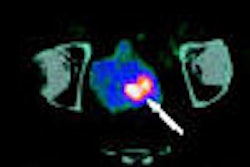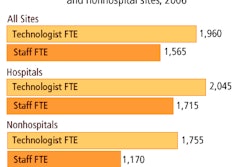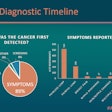CHICAGO - An improvement in contrast may be one reason that full-field digital mammography (FFDM) performs better than film-screen mammography (FSM) in certain subgroups of women, according to the lead investigator of the Digital Mammographic Imaging Screening Trial (DMIST). Dr. Etta Pisano presented updated results Sunday at the RSNA meeting.
Data from DMIST was first published in September 2005. In brief, the results stated that FFDM was superior to FSM for detecting cancers in younger women, while also proving more accurate in radiographically dense breasts, premenopausal women, and perimenopausal women (New England Journal of Medicine, September 15, 2005).
In her RSNA talk, Pisano stressed that the concept of a difference in contrast was a theory that the DMIST investigators were looking at with an ongoing reader study with results available in 2007.
"Why did we get the results that we did?" she asked. "We believe that the results -- and this is our hypothesis -- is that improved contrast for digital mammography is likely to be a factor that improved performance (in certain subgroups)."
DMIST, sponsored by the American College of Radiology Imaging Network (ACRIN), involved nearly 50,000 asymptomatic women who presented for screening mammography at 33 sites in the U.S. and Canada. Five different FFDM systems were used:
- SenoScan (Fischer Imaging, Denver)
- FCRm (Fujifilm Medical Systems USA, Stamford, CT)
- Senographe 2000D (GE Healthcare, Chalfont St. Giles, U.K.)
- Selenia Full Field Digital Mammography System (Hologic, Bedford, MA)
- Lorad/Trex Digital Mammography System (Hologic), subsequently replaced by Lorad/Hologic Selenia Full Field Digital Mammography System (Hologic)
According to newer analysis, there was no significant difference among the various FFDM machines and FSM, Pisano said. The results for Fischer's unit overlapped with FSM results, although this unit missed more cancers in women over age 65, she explained.
The Fuji and GE digital machines did perform better, but again, not significantly so, she said. The number of patients imaged with the Lorad/Trex/Hologic units was too small to analyze, she added.
Preliminary results from the current reader study continue to support FFDM as superior to FSM in certain women depending on their age, menopausal status, and breast density, Pisano said. In this analysis, a p-value of less than 0.002 was required to achieve statistical significance. Once again, FFDM proved to be better in pre- or perimenopausal women under age 50, with dense breasts (p = 0.0015). In women over age 65 with fatty breasts, FSM tended to perform better, but not significantly (p = 0.0025), she added.
"My own hypothesis is that FFDM may be optimized for dense breasts but not fatty breasts," Pisano said.
Dr. Daniel Kopans of Massachusetts General Hospital in Boston asked Pisano if the DMIST group had looked at whether differences in reader skills affected the results, using a side-by-side comparison of FFDM and FSM. Pisano responded that that data was currently being studied, but that improved contrast with digital may be the key element.
FFDM costs
In another talk, Dr. Anna Tosteson discussed the cost-effectiveness of FFDM for breast cancer screening. Tosteson and colleagues are from the Dartmouth-Hitchcock Medical Center in Lebanon, NH.
"Higher payments for digital screening and rising healthcare costs motivate interest in the economic value of digital mammography screening," Tosteson said. For this research, a U.S. population simulation model of breast cancer was devised, based on 1999 screening patterns (Journal of the National Cancer Institute Monographs, 2006, Vol. 36, pp. 37-47).
Four screening strategies were evaluated:
- FSM for all women (all-SF)
- FFDM for women under 50 years of age and for women over 50 (age-targeted)
- Women in the age categories above, further subdivided by breast density (age-density-targeted)
- FFDM for all women (all-DM)
DMIST performance characteristics and workup were used such that an exam was considered workup-positive if the radiologist recommend additional evaluation or assigned BI-RADS categories 0, 4, or 5, Tosteson explained.
Data was generated for tracked life years (LY), quality-adjusted life years (QALY), costs ($86 for SFM; $135 for FFDM), clinical detection, and treatment under each screening strategy. Finally, incremental cost-effectiveness ratios (ICERs) were computed using 3% discounting of costs and health benefits.
According to the results, targeted FFDM strategies yielded more screen-detected cancers, but fewer clinically detected cancers than all-SF. The age-targeted strategy was associated with ICERs that ranged from $22,400 to $57,600 per QALY gained. The age-density-targeted strategy had ICERs that ranged from $26,300 to $75,000 per QALY gained. All-DM cost more than age-density-targeted DM and was no more effective than age-targeted DM.
The ICERs for all-DM was $282,000 per LY gained versus $331,000/LY for all-FS. The cost of FFDM would need to drop from $135 to $92 per screening exam before an all-DM model would cost less than $50,000/QALY gained, the group stated.
Ultimately, the researchers concluded that targeted FFDM strategies appeared to be the most cost-effective. In the Medicare population in particular, all-DM leads to higher costs and potentially worse health outcomes, they added.
"Digital mammography screening for all women does not provide sufficient health gains to warrant the increase costs," she said.
Tosteson pointed out that her group did a societal analysis of the cost of FFDM versus looking at the direct financial impact of FFDM on a practice, such as potentially lower expenses related to film or the costs associated with maintaining FSM while switching to FFDM.
By Shalmali Pal
AuntMinnie.com staff writer
November 26, 2006
Related Reading
FFDM may make mobile breast cancer screening programs more viable, November 29, 2005
Do DMIST results underestimate FFDM's impact? October 24, 2005
Harnessing technology, training to make the most of FFDM, October 3, 2005
DMIST study: Younger women may benefit most from digital mammo, September 16, 2005
Copyright © 2006 AuntMinnie.com



















